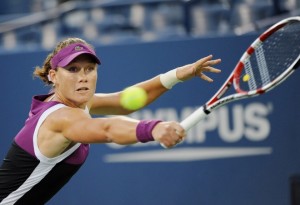By Thomas Swick
swickt@bellsouth.net
My favorite court looked as if it had concluded its singles life for the U.S. Open 2011 – after Donald Young took out Juan Ignacio Chela in straight sets yesterday afternoon – but by some lucky stroke the Maria Kirilenko-Samantha Stosur match was moved there for the evening.

It began so prosaicly – Stosur taking the first set easily – that I wandered over to Gate 16 and struck up a conversation with one of the ushers. This was Kennard P. Rawson’s sixth year at the Open, and each one of them he had spent at Gate 16.
“It’s a difficult spot,” he explained, “because you’ve got to deal with people coming from two stadiums.” (The Grandstand sits in the shadow of Louis Armstrong, and the corridors of one bleed into the other.) “It’s also one of the busiest gates. And,” he added with a note of pride, “I think the fastest.”
A white handlebar mustache ribboned Rawson’s sun-burned face; tufts of white hair fluffed the sides of his cap.
“I really enjoy this spot,” he said, “and I enjoy the guy I work with. You get tired. You get frustrated. You run into people who get angry over something you probably have nothing to do with. But I’ve made a lot of friends in six years.”
He turned his attention to a woman waiting in line. “Don’t worry,” he told her confidently, “we’ll get the whole line in.”
I asked him if he ever saw celebrities.
“I see Pancho Segura every year,” he said. “I like him very much. I’m a racquet collector, and I’ve got a couple Pancho Segura racquets.”
“Any particularly memorable matches that you’ve seen?”
He thought for a long time and said: “Nothing comes to mind. I’ll probably wake up tonight and think of one. But I remember the little things. Like the other day a guy fell down, playing against Del Potro, and Del Potro came over and offered him a towel.”
A game had ended, Rawson got back to work, and I returned to my seat for the second set tiebreak.
The lead went back and forth, both women hitting ferociously, Kirilenko with loud utterances, Stosur in stoic silence. She seemed to have the most support, but by the time the points played reached 13, there arose a great divide between the players, who wanted the tiebreak to be over as soon as possible (each on her own terms of course), and the fans, who now wished it to go on and on. The nearly packed house had gone from cheering for a player to rooting for a drama. They had found, at last, their classic U.S. Open night match.
At the now almost unprecedented number of changeovers, both players took their time drinking and toweling off. Then they returned, almost disbelieving, to the court. The score continued to mount, as did the noise. In a facility where you’re constantly thinking you should be somewhere else – “Wonder what’s happening on Court 17” – you knew there was no other place to be.
Stosur got five match points and lost them all, two of them to challenges. The roars greeting the pictures that appeared on the big screen of a thick white line eclipsed, once just barely, by a shadowy sphere would have converted any doubters of the replay system. At 16-15 Stosur sent a shot wide, and the pandemonium of the crowd belied its disappointment that the epic duel was over.
And it was, as Stosur undeflatedly, and unremarkably, won the third set 6-3. But we had witnessed not only drama but history: the longest women’s tiebreaker in Grand Slam history. And Kennard P. Rawson had been given an answer for the next time someone asks him about a memorable match.
